In today’s fast-paced and competitive world of work, the quest for happiness often takes a backseat. But the key to unlocking workplace success lies in fostering a happier workplace.
In the run-up to the International Day of Happiness, greytHR launched a survey among HR admins, business owners, and employees. The goal is to delve into the factors influencing employee happiness. The findings reflect the aspirations, challenges, and opportunities of creating work environments with happy people.
Methodology of Analysis
Out of the 654 participants selected for this survey, 522 were HR admins and business owners, while 132 were employees selected from the LinkedIn platform. This data was anonymized to maintain sanctity. The six questions in the survey have multiple answers, and the respondents could choose more than one.
The Pursuit of Happiness: More than Just a Paycheck
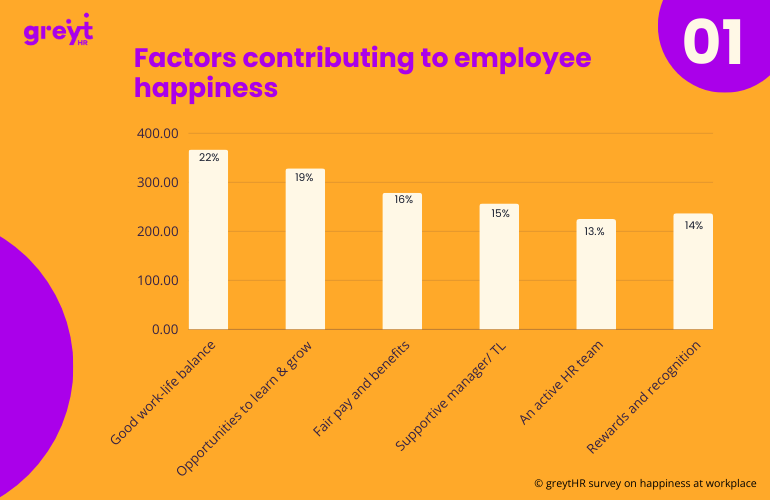
At the core of our findings is a simple yet profound truth: employee happiness transcends monetary compensation. The below graph illustrates the diverse factors contributing to employee happiness at the workplace. 22% of respondents to this question selected a ‘good work-life balance’ as the most crucial factor. ‘Opportunities to learn & grow’ and ‘fair pay and benefits’ come in close succession to this. ‘Supportive manager/TL’ and ‘rewards and recognition’ also play vital roles but to a slightly lesser extent.
Recognizing the Unsung Heroes
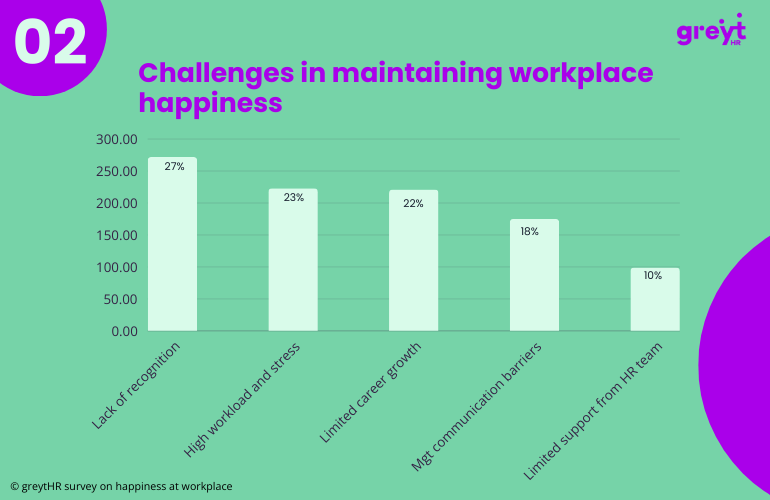
The path to happiness is not without its obstacles. As per the findings, and depicted in the graph, 27% of respondents found ‘lack of recognition’ to be the most significant hurdle. This is closely followed by ‘high workload and stress’ and ‘limited career growth’. Furthermore, ‘management communication barriers’ and ‘limited support/initiatives from HR team’ were also noted as obstacles.
Happiness and Recognition: A Dynamic Duo
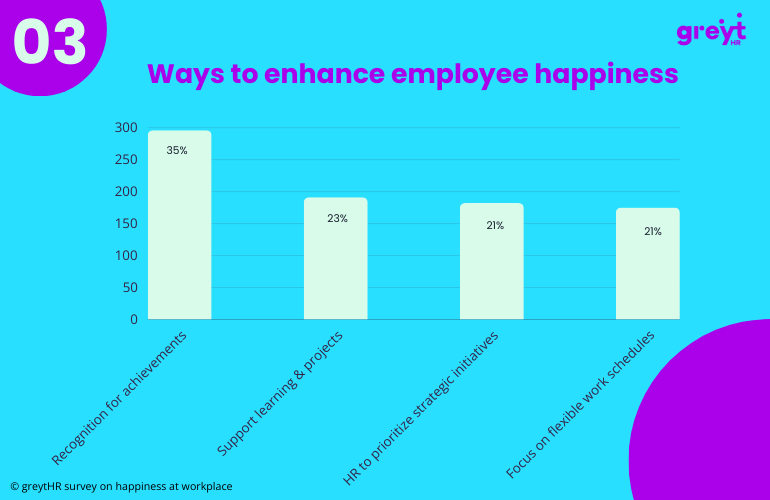
How do we gauge the intangible, multifaceted nature of happiness? As shown above, the most prominent way for enhancing happiness and satisfaction (35% of the responses) is 'recognition for employee achievements’. ‘Support for personal learning & projects’ and ‘empowering HR to prioritize strategic initiatives over routine tasks’ were the next best choices.
Measuring Happiness: Beyond the Surface
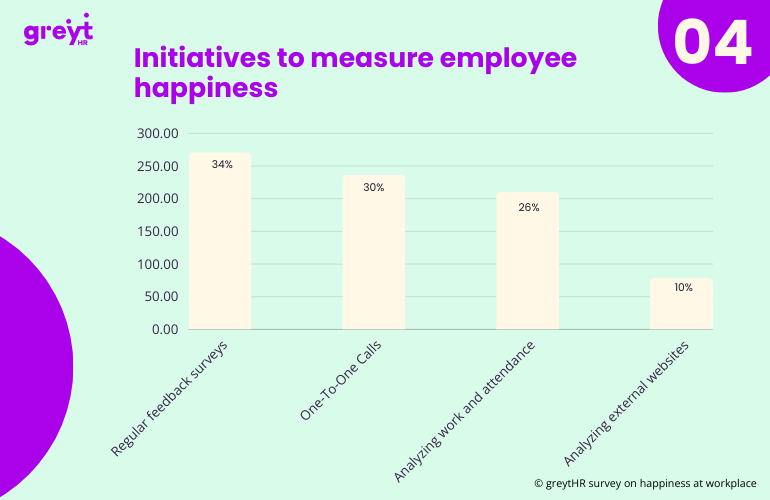
Everybody wants to be heard! This part of the survey delves into how organizations ascertain whether their employees are happy at work. The data reveals a strong preference for ‘regular employee feedback surveys,’ with 34% of respondents zeroing in on this method. ‘One-to-one calls/sessions’ also play a significant role, as indicated by 30% of the responses. Interestingly, a smaller percentage of respondents mentioned ‘analyzing external websites’ as a method. This suggests that internal feedback mechanisms are prioritized over external perceptions.
A Quarterly Reflection: The Rhythm of Happiness
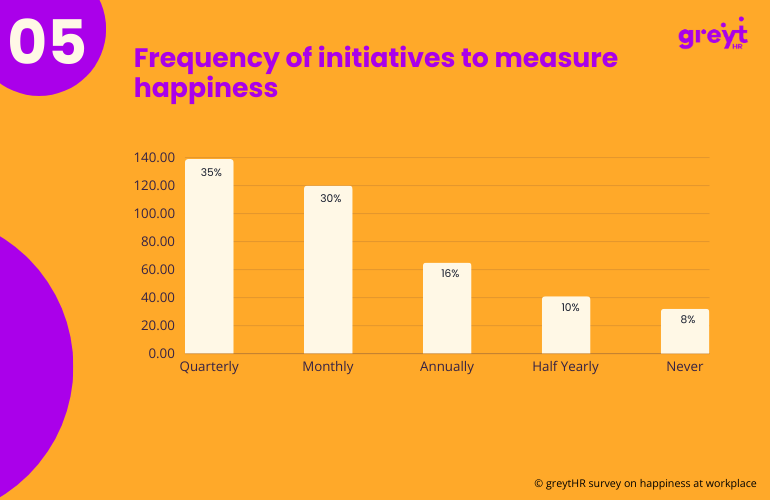
The frequency of initiatives to measure and enhance happiness is a balancing act. The fifth question explored how often organizations assess employee happiness and satisfaction. The findings indicate that 35% of respondents preferred ‘quarterly’ measurements. ‘Monthly’ measurements follow closely, with 30% of the responses. Annual and half-yearly assessments are less common.
Employees' Take: Flexibility, Opportunity, and Beyond
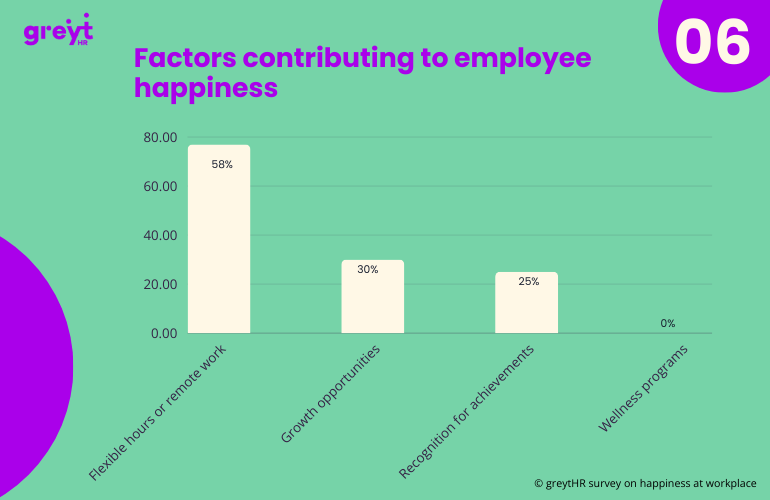
Autonomy and opportunity are the cornerstones of a happy work environment. The visualization for this section of the report outlines the employees' perspectives on ways to improve happiness at the workplace. ‘Flexible hours or remote work’ emerges as the top factor according to 58% of the respondents. There were 23% of responses for growth opportunities. Surprisingly, wellness programs are featured at the bottom of the list.
While HR thinks that rewards and recognition make employees happy at the workplace, employees derive happiness from flexible hours or remote work.
Key Insights
- Employee Happiness Factors: A good work-life balance is paramount, along with opportunities for growth, fair compensation, and recognition.
- Challenges: The primary obstacle is the lack of recognition, highlighting the need for businesses to acknowledge and reward their employees' contributions effectively.
- Enhancing and Measuring Happiness - Recognition for achievements plays a major role in enhancing happiness and regular feedback surveys help keep a pulse on employee happiness
- Frequency of Initiatives: Many organizations conduct happiness measurement initiatives quarterly, balancing the need for regular insight with operational feasibility.
- Recommendations: Flexible working hours and the option for remote work are highly recommended to boost employee happiness and adapt to modern work-life balance expectations.
In Conclusion
The insights from the greytHR survey serve as a beacon, guiding us toward a more empathetic approach to workplace happiness. It's a journey that requires us to listen, adapt, and celebrate the human elements that make our work meaningful. At the end of the day, happy and productive employees help make an organization resilient and successful.
Let's embrace these findings not just as numbers but as a call to action ‒ to build workplaces where happiness is the foundation of all we do. Let’s create a future where work feels less like an obligation and more like an opportunity for joy and fulfillment.
Disclaimer
The strategies and insights provided in this blog are intended for informational purposes only. greytHR's data and responses from a LinkedIn poll have been used in this survey. While every effort has been made to ensure accuracy and reliability, the data is provided "as is," and the interpretations of the data are the author's own. Readers should consider the data in the context of broader economic and societal trends and are encouraged to seek additional sources of information before forming conclusions.








